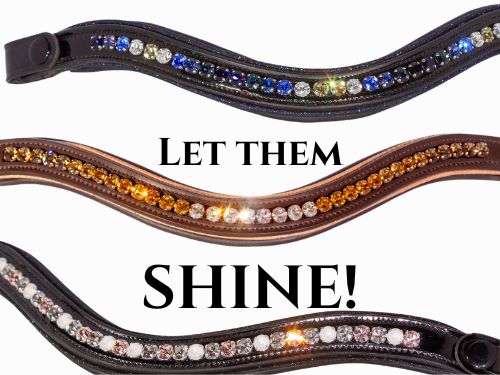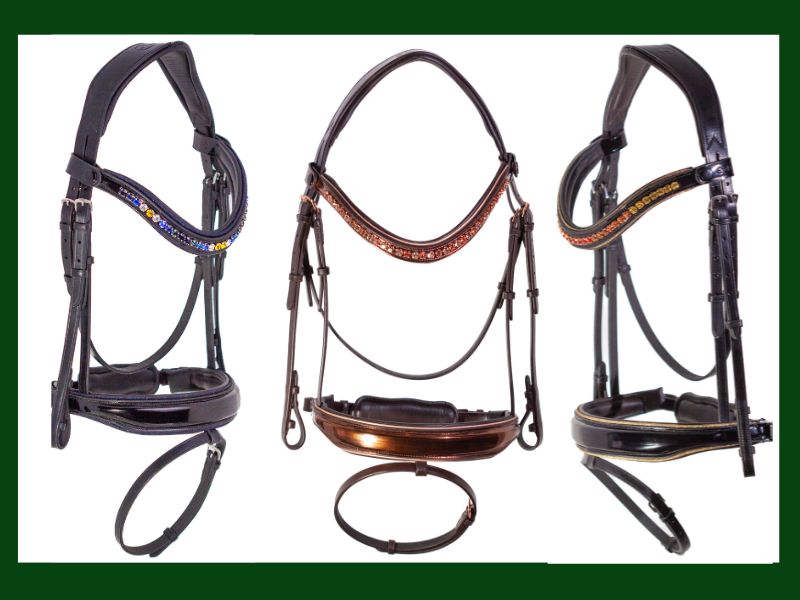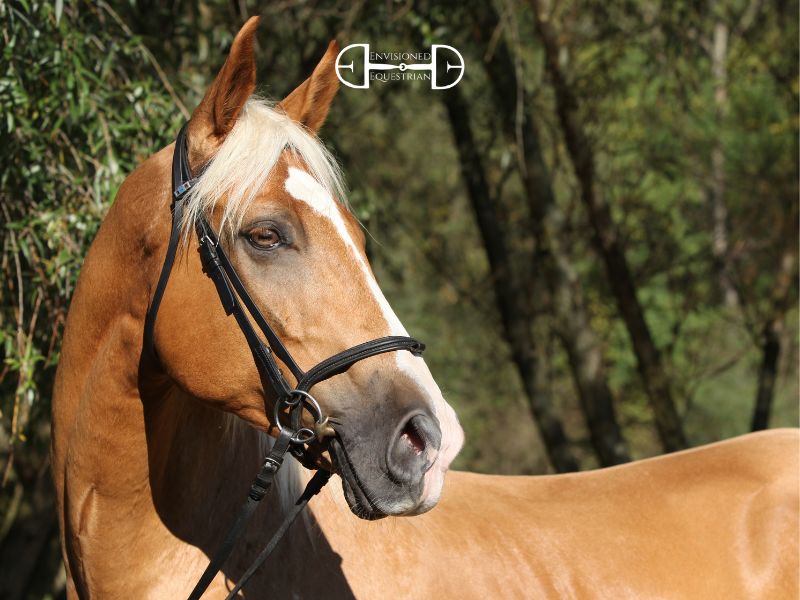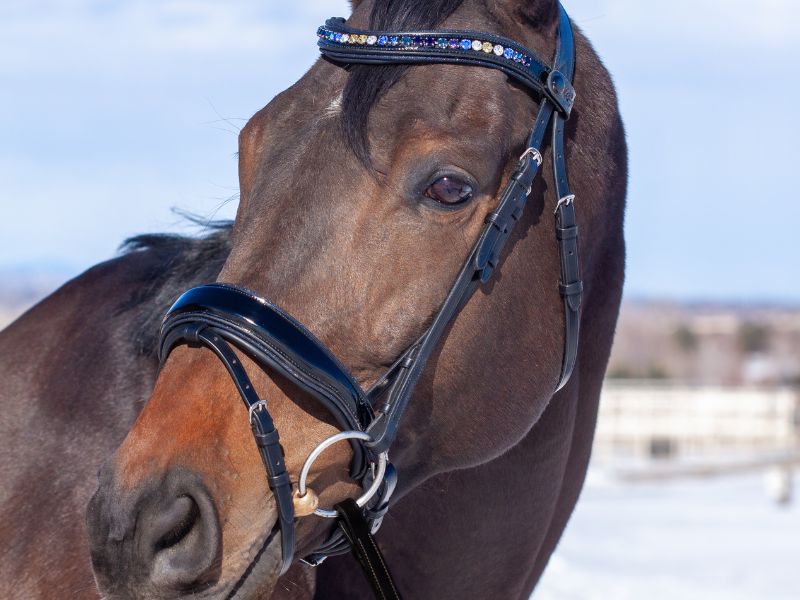
by LaceyKnight | Feb 13, 2025 | Horses, Leather goods
For as long as humans have worked with horses, different forms of bridles have been used to communicate and guide them. The bitless bridle is not a modern invention but a practice with deep historical roots. From ancient civilizations to today’s equestrian world, it has played an essential role in horse training and riding, offering a gentle, more equine-centric alternative to traditional bitted bridles.
The Historical Use of Bitless Bridles
Early horsemen used variations of the bitless bridle long before the widespread adoption of metal bits. Ancient cultures, including the Persians, Native American tribes, and Mongolian warriors, relied on rawhide, braided rope, or leather headgear that applied pressure to the nose and poll to communicate with their horses. These designs allowed for effective control without the potential discomfort or damage caused by metal bits.



During the Middle Ages, knights often rode with hackamores—a type of bitless bridle that uses nose pressure for guidance. In regions where precision and harmony with the horse were crucial, riders refined bitless designs to create subtle yet effective means of control.
Why the Bitless Bridle Matters Today
In modern equestrian disciplines, bridles without bits have seen a resurgence, particularly among riders who prioritize horse comfort and natural horsemanship. Here’s why they continue to gain popularity:
- Horse Welfare: A bitless bridle eliminates pressure on the mouth, reducing the risk of discomfort, pain, or injury to the tongue, bars, and palate.
- Versatility: Suitable for various disciplines, including dressage, endurance riding, and trail riding, the bitless bridle offers an effective alternative for riders seeking a gentler form of communication.
- Encourages Trust and Connection: Riding with a bitless bridle fosters a deeper bond between horse and rider, relying on seat, leg, and rein cues without the need for a metal bit.
- Ideal for Sensitive Horses: Some horses have dental issues, past trauma, or naturally soft mouths that make a bitless bridle a more comfortable option.
The Future of the Bitless Bridle
As awareness of equine welfare continues to grow, more riders and trainers are exploring the benefits of going bitless. While traditional bitted bridles remain common, advancements in bitless designs provide riders with options that align with their horse’s needs and riding goals. Whether used for daily riding, competition, or rehabilitation, the bitless bridle is proving to be a timeless and valuable tool in the equestrian world.
Stay tuned for the big reveal of our Envisioned Bitless Bridle! Coming Spring 2025.
Want the perfect browband to go with your bitless bridle? Find them here.
Not yet ready to go bitless?
Want a basic overview of the history of tack in general? Go here.

by LaceyKnight | Feb 12, 2025 | Browband, Horses, Leather goods
A rhinestone browband isn’t just an accessory—it’s a way to express your style while complementing your horse’s natural beauty. But with so many colors, shapes, and styles available, choosing the perfect one can feel overwhelming! This guide will help you find the ideal rhinestone browband based on your horse’s coat color, your riding discipline, and your personal style.
1. Match the Browband to Your Horse’s Coat Color
Certain colors enhance your horse’s natural tones, making their features pop! Here are some general guidelines:
- Dark Bay & Black Horses: Jewel tones like emerald green, sapphire blue, or rich burgundy stand out beautifully. Metallics like gold and silver also add a striking contrast.
- Chestnut & Red-Toned Horses: Warm tones like amber, copper, or champagne complement their coats. Deep blues and greens can create a bold contrast.
- Grey & White Horses: Almost any color works, but pastels, cool blues, and deep purples look especially elegant.
- Palomino & Buckskin Horses: Earthy tones like bronze, topaz, and soft rose gold enhance their golden hues.
2. Consider Your Riding Discipline
Your choice of rhinestone browband should align with your riding style and competition rules:
- Dressage Riders: Bold, elegant designs with larger stones or intricate patterns add a touch of refinement.
- Hunter/Jumper Riders: Classic, subtle bling works best—opt for neutral tones or a single-row design for a polished look.
- Eventers & Trail Riders: Go as bold as you like! Vibrant colors and unique patterns let you showcase your personality.
3. Reflect Your Personal Style
A rhinestone browband is an extension of your personality! Ask yourself:
- Do you prefer subtle elegance? Try a single-row browband with neutral or metallic stones.
- Love bold, eye-catching bling? Go for wave designs with contrasting colors and bright rhinestones.
- Want a theme or special meaning? Some browbands feature patterns or colors inspired by just about anything and everything. Read product descriptions to learn more about each one!
4. Prioritize Quality and Fit
A well-made rhinestone browband should be both stunning and durable. Look for:
- Strong stitching and high-quality leather for longevity.
- Securely set rhinestones that won’t fall out after a few rides. All of our stones are hand-set to ensure their security so you can enjoy them, ride after ride!
- A comfortable fit—ensure it sits properly on your horse’s forehead without pinching. Need help finding the perfect fit?
Final Thoughts
Choosing the perfect rhinestone browband is about balancing color, discipline, and personal style while ensuring comfort and durability. Whether you go for classic elegance or bold sparkle, the right browband will make both you and your horse shine in and out of the arena!
What’s your go-to browband style? Share your favorites below!

by LaceyKnight | Feb 12, 2025 | Browband, Leather goods, Tack care
A rhinestone browband is more than just an accessory—it’s a statement. Whether you love bold, flashy designs or elegant, subtle sparkle, a well-maintained browband enhances your horse’s look and ensures your tack stays in top shape. But let’s be real—dust, sweat, and everyday riding can dull that shine. So, how do you keep your rhinestone browband looking brand new? Here’s everything you need to know!
1. Regular Cleaning: Wipe Away the Dust and Grime
Your rhinestone browband picks up dust, sweat, and barn dirt faster than you think. To prevent buildup:
- After each ride, use a soft, dry cloth to wipe away any surface dust.
- For deeper cleaning, dampen a microfiber cloth with water or a mild leather cleaner and gently wipe the leather and rhinestones.
- Avoid soaking the browband—excess moisture can loosen stones over time.
2. Use the Right Cleaning Products
Not all cleaners are created equal! To preserve both the leather and the sparkle:
- Use a gentle leather cleaner for the browband itself—harsh chemicals can dry out or discolor leather.
- For rhinestones, a tiny drop of mild dish soap diluted in water works wonders. Apply with a soft toothbrush or cotton swab to get into the crevices without scratching the stones.
- Never use alcohol-based cleaners or abrasive pads—these can damage the shine and loosen the settings.
3. Store It Properly
Proper storage prevents unnecessary wear and tear:
- Keep your rhinestone browband in a soft cloth bag or padded bridle rack when not in use.
- Avoid tossing it into a tack trunk where it can rub against other gear and get scratched.
- Store in a cool, dry place—excess humidity can weaken glue settings, while extreme heat can cause leather to crack.
4. Handle with Care
Rhinestones add undeniable glamour, but they’re delicate!
- Avoid dropping or bending your browband, as this can loosen or dislodge stones.
- Be mindful when adjusting your bridle to avoid tugging on the rhinestones or pressing them against hard surfaces.
- If you notice a loose stone, secure it with a tiny dab of jewelry glue, or take it to a professional for repair.
5. Give It a Professional Refresh
Even with the best care, rhinestones can lose some of their brilliance over time. If your browband needs a little extra TLC:
- Take it to a leather specialist for professional cleaning and conditioning.
- If stones become dull or missing, consider a custom replacement or upgrade to keep your browband looking as dazzling as the day you got it.
Final Thoughts
Your rhinestone browband is meant to shine—so keeping it clean and well-maintained ensures it stays the centerpiece of your horse’s bridle. With these easy care tips, you’ll keep your browband sparkling ride after ride!
How do you keep your tack looking its best? Share your favorite care tips!
In the mood for some sparkle? View our rhinestone browbands here.

by LaceyKnight | Jan 27, 2025 | Browband, Gratitude, Horses, Inspiration, Leather goods, Uncategorized
It all started with jewelry. I was crafting sparkly accessories to pair with some new dresses I absolutely adored. One afternoon in September 2024, while my husband and I were driving somewhere, I mused aloud, “I wish I could make browbands.” Dave, ever the optimist, simply replied, “Why can’t you?”
That was the spark. That moment grew into an office overflowing with tack, walls lined with crystals, and endless hours spent researching materials, manufacturers, and trends in the luxury tack industry. It was a journey I hadn’t anticipated but embraced wholeheartedly.
Dancing Like Nobody’s Watching
Someone recently asked me why I’m doing this. The best answer I could give was that it feels like dancing like nobody’s watching. There’s freedom in artistic expression—in pouring your heart into something and putting it out into the world. It might succeed, or it might not. You might face embarrassment, or you might not. But at the heart of it, your contribution adds a touch of beauty to the world, something someone else might need. And for me, that beauty takes the form of rhinestone bridles and browbands.
An Affinity for Rhinestone Bridles
When I was younger, every time a new horse entered my life, my favorite ritual was finding the perfect bridle. I’d spend hours flipping through catalogs, evaluating styles, and imagining how they’d look on the horse. This was long before the internet, so catalogs like Dover, Stateline Tack, and Dressage Extensions were my treasure troves. I had them memorized, page by page.
Despite the variety, most bridles back then lacked character. Crystals and rhinestones had yet to make their way into mainstream tack. Clinchers and chains were the extent of “bling,” and even those were more common in eventing than dressage. For dressage riders, bridles were—quite literally—black and white.
The first rhinestone bridle I remember seeing was an Otto Schumacher. It featured sleek black patent leather, plush white padding, and a delicate browband with dazzling white crystals. It was a revelation, a beacon of elegance in an otherwise stark world. That memory stayed with me.
The Return to Bling
For a time, I stepped away from tack. I worked with a natural horsewoman whose training methods emphasized the pure connection between horse and rider, unadorned by anything flashy. I learned invaluable lessons about reading and understanding horses, but eventually, the rhinestones called me back.
One of Einstein’s quotes hangs near my dad’s workshop: “Imagination is more important than knowledge.” My dad often added, “Why not both?” Tack-making embodies that sentiment. It requires knowledge—of materials, sizing, equine physiology, and design—but the creative possibilities are endless. That’s what excites me about this work.
Discovering Halter Ego
A month into making browbands, I discovered Halter Ego. Their products were stunning. I thought, “This is what I want to create,” but at a more accessible price point—perhaps half, or even a quarter of their cost.
Finding a great manufacturer is no small feat, but I was fortunate to connect with one early on. We’ve spent countless hours collaborating, and their support has been invaluable. Still, Halter Ego’s designs continued to inspire me. I asked myself: Would people prefer two or three rhinestone browbands for the price of one? I imagined riders swapping out browbands to match their pads and wraps, creating a cohesive, polished look. That’s where my vision took root.
The Birth of a Brand
When my first shipment of browbands and halters arrived, I scrutinized every stitch. To my surprise, the quality rivaled that of Halter Ego. I was thrilled. My little experiment was working, and my brand was officially born.
The bit in my brand comes from my soul horse’s hunter bridle. Envisioned was his name, and that KK D-ring Snaffle was the berries. So, why not use it since all of this is really about things I would have wanted for him?
Expanding to Rhinestone Bridles
Transitioning from browbands and halters to full bridles was a natural progression but required careful planning. Every detail—from stitching to crystal placement—had to contribute to a cohesive design.
As a child, I loved drawing horse portraits, and I still do on occasion. When I see a horse in one of my bridles, my mind immediately envisions a portrait—a celebration of their natural beauty, enhanced by the sparkle of rhinestones. Designing rhinestone bridles feels like an honor, a way to highlight the grace and elegance of these incredible animals.
Where It All Leads
Today, I’m surrounded by bridles, sticky notes, and sparkly creations, typing about my favorite subject: rhinestone bridles and browbands. Who would have thought a few dresses from Sundance would inspire this passion project?
To those who share my love of equestrian bling: I want to hear from you. What designs have you dreamed of but haven’t seen in the world? Let’s collaborate and bring those visions to life—for the horses.

by LaceyKnight | Jan 18, 2025 | Bridle & Halter Fitting, Horses, Leather goods
I got all excited, and then they burst my bubble…with good reason.
In Need of an Anatomical Bridle
I have a friend with a horse who has a bone spur on his poll. The radiograph is disturbing; however, he can be ridden comfortably in the right tack.
She enlisted my help, and I jumped at the opportunity to create something for him. I began to draw and came up with what seemed like the perfect solution to this anatomical quandary. The design looked a lot like the Antares bridle but utilized less surface area so as to keep the pressure as localized yet well-distributed as possible.
Jumping at the Opportunity for a New Bridle
I was over the moon for this idea. I called my manufacturer and sent over the drawings. This would be possible. My heart leaped at the thought of creating something for all horses everywhere that could enhance their comfort while being ridden. I was so excited.
I had an order in the pipeline, so I got in there and changed all my bridles to a modified version of this new poll-relief design, whereby the padding would offer the poll and spine a channel of relief and more surface area for a more well-balanced crownpiece.
That Feeling You Get
I dreamt about it. I fantasized about how great this was going to be, and yet something nagged at me. I could not tell what this feeling was, but there in my gut it resided, and I knew something was wrong.
The same friend who needed the crown piece shared with me that the USEF had outlawed these poll-relief bridles for showing. I was perplexed. The design, in my mind, was absolute poetry. How could something that made the horse more comfortable, something more anatomical, be bad?
When I took the time to read the document, it made total sense. The weight of the entire bridle rests on the crown. When you divide up the padding or change how the crown sits, you induce uneven, increased pressure on both sides of the neck behind the poll. This may not be hugely impactful if you ride in a plain snaffle, but imagine how it might harm a horse if you ride in a double, or with training aids like side reins, draw reins, or a martingale. My big anatomical bridle bubble had burst.
I consulted one of my great friends who fits tack for a living. She didn’t even have a conversation with me. She just sent over the document for me to read. I understood. There was no getting around this. The poll-relief bridles, as they stand, are not in the horse’s best interest. You can read the USEF’s document here.
The Experimental Poll-Relief Bridle
Now, as for my friend in need, of course, we are moving forward with the experimental bridle for him. He is a special case, and we cannot overlook his bone spur that interferes with the crown of a normal bridle.
We need to offer him some relief.
The slightly uneven pressure will be a small price to pay for him. And bear in mind this is an experiment. We do not know if he will be rideable even with the modified bridle, but we are going to try for him.
Why Classical Bridles Outshine Some Modern Poll-Relief Bridle Trends
All of this is to say that trendy tack that is marketed well as anatomical, relieving of pressure, or ergonomic might not actually be so when it gets right down to the brass tack 😉
So, history wins when it comes to this particular argument. Classical is better than “modern” in this specific case.
If you want one of these new designs, I do advise against it. Let’s have a conversation about it. When you think about it for a brief moment, I feel like you, too, will come to the same conclusion that these bridles are not in the horse’s best interest.
In celebration of equines everywhere,
Lacey Knight
P.S. I did go back and undo the poll-relief crowns in my upcoming order. So the Rare Earth Elements Collection will feature normal, cutback, padded ergonomic crowns.
Need help with bridle fitting? Go here for an easy guide.

by LaceyKnight | Jan 14, 2025 | Bridle & Halter Fitting, Leather goods, Tack care
When it comes to equestrian equipment like rhinestone bridles and crystal halters, achieving the perfect fit is essential for both your horse’s comfort and performance. At Envisioned Equestrian, we believe that every piece—from brand-new luxury tack to your soft-as-butter ancient favorite—should not only look stunning but also fit seamlessly. Here’s a comprehensive guide to ensure your bridles and halters fit just right, keeping your horse happy and looking their best.
Why Proper Fitting Matters
An ill-fitting bridle or halter can cause discomfort, rubs, and even behavioral issues in your horse. A correctly fitted piece enhances communication and performance while showcasing your horse’s natural elegance. Whether you’re using a functional everyday halter or an exquisite rhinestone bridle, the right fit is non-negotiable.
Bridle Fitting Basics
1. Measuring for a Bridle
Start by measuring your horse’s head to determine the appropriate size. Most luxury bridles, including those at Envisioned Equestrian, are available in Cob, Horse, and Warmblood sizes. For custom measurements, focus on the:
- Browband: Should sit comfortably across the forehead without pinching behind the ears. A rhinestone browband, like our Winter’s Wake or Phoenix designs, adds sparkle while enhancing fit.
- Crownpiece: Should rest behind the ears without pressing on sensitive areas. Ergonomic designs are ideal for distributing pressure evenly.
- Cheekpieces: Adjust so the bit rests gently against the corners of the mouth, creating a soft wrinkle. Avoid over-tightening, as this can cause tension.
- Throatlatch: Leave enough space for four fingers between the strap and the horse’s jaw to ensure breathing is unrestricted.
2. Finding the Right Bit Position
The bit should sit evenly in the horse’s mouth, with no excessive movement. Check for proper bit fit by ensuring about 1/2 inch of space on either side of the mouth. Many horses have tongues that vary in thickness and cheeks that do so as well. When you fit a bit, you want to make sure you take these two things into consideration as well. If you like chunky bits, take a peek inside your horse’s mouth first to see how much room they have in there. Getting a big rubber bit may seem like a kind thing to do, but if they don’t have enough room in their mouth, it’s just as detrimental as getting a harsh bit that is uncomfortable for them.
3. Adjusting Nosebands
Nosebands should be snug but not tight. You should be able to fit two fingers underneath the band. This prevents discomfort and allows the horse to move its jaw naturally. Luxury bridles often feature padded or contoured nosebands for additional comfort. At Envisioned Equestrian, our nosebands take a few days to soften and bend to fit the horse’s face. Once it’s softened, you’ll have more room for adjustments.
Spotlight on Rhinestone Bridles
Rhinestone horse bridles are more than just functional; they’re a statement. Envisioned Equestrian’s collection features dazzling designs like the Twilight Tranquility or Sugar Plum browbands, perfect for adding a touch of glamour. When fitting rhinestone bridles, ensure the added embellishments don’t interfere with the horse’s movement or comfort. A well-fitted rhinestone bridle should frame your horse’s face beautifully while staying secure during work or play.
A properly fitted halter is crucial for daily handling and groundwork. Envisioned Equestrian’s crystal halters, such as the Glacial Waters Rhinestone Halter, combine elegance and practicality. Here’s how to ensure a perfect fit:
1. Adjusting the Crownpiece
The crownpiece should sit comfortably behind the horse’s ears. Opt for padded options to reduce pressure and enhance your horse’s comfort, especially during prolonged wear.
2. Finding the Right Noseband Fit
The noseband should rest about two fingers below the horse’s cheekbone. It should be snug enough to prevent slipping but loose enough to avoid pinching. Crystal horse halters with ergonomic designs offer a blend of fit and fashion, ensuring your horse stays comfortable while looking stunning.
3. Checking the Throatlatch
Ensure you can fit three fingers between the throatlatch and the horse’s jaw on a halter. This allows freedom of movement without compromising security.
Signs of a Poor Fitting Bridle or Halter
Whether it’s a bridle or a halter, look out for these red flags:
- Rub Marks or Hair Loss: Indicates excessive pressure or friction.
- Behavioral Issues: Head tossing, resistance, or discomfort during use may signal an improper fit.
- Uneven Wear: Check for imbalances, particularly in the bit or straps.
Addressing these issues promptly can prevent long-term discomfort or injury.
The Envisioned Equestrian Difference
At Envisioned Equestrian, we’re dedicated to creating rhinestone bridles and crystal halters that blend luxury and functionality. All our pieces are crafted with attention to detail, ensuring they’re as comfortable as they are stylish. Our custom sizing options mean every horse—from ponies to warmbloods—can enjoy the perfect fit.
Final Tips for Bridle Fitting Success
- Regular Checks: Horses’ shapes change over time. Reassess the fit of your bridles and halters periodically.
- Keep It Clean: Dirt and sweat can cause irritation. Clean your luxury bridles and crystal halters regularly to maintain both their beauty and functionality. Need help caring for your Envisioned Equestrian Leather? Go here.
- Seek Professional Help: If you’re unsure about the fit, consult a professional fitter or your trusted tack supplier.
When your horse’s equipment fits perfectly, they’re more comfortable, confident, and ready to shine—whether in the show ring or during daily rides. Explore Envisioned Equestrian’s stunning collection of rhinestone horse bridles and crystal halters to combine impeccable fit with unparalleled style.









